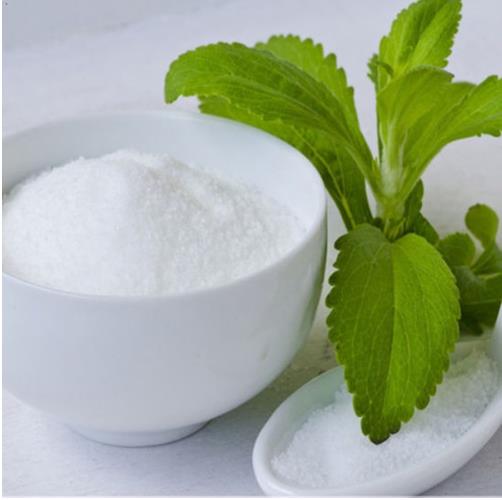Stevioside Basic Information: An Insight for Professionals in Chemistry
Jun 24,2024
Introduction
Stevioside, a natural sweetener extracted from the leaves of the Stevia rebaudiana Bertoni plant, has been attracting considerable attention in the food industry and among health-conscious consumers for its unique properties and multifaceted benefits. Unlike typical sugar substitutes, stevioside showcases a complex chemical makeup that extends its utility beyond mere sweetening. It serves not only as a healthier alternative to traditional sugars due to its non-caloric nature but also offers versatility in food science applications. Its ability to remain stable under heat and resist fermentation enhances its appeal in culinary and industrial applications, positioning it as a standout ingredient in the evolving landscape of food additives.

Figure 1 Characteristics of Stevioside Basic information
Properties
Stevioside is a glycoside composed primarily of steviol and glucose molecules. Structurally, it is characterized by a backbone of steviol, a diterpene compound, bonded to glucose units. This composition renders stevioside approximately 200-300 times sweeter than sucrose. One of the hallmark properties of stevioside is its high stability under various conditions. It is stable at high temperatures and does not ferment, which makes it ideal for cooking and baking applications where other sweeteners may degrade or lose sweetness.
The compound is also known for its negligible impact on blood glucose levels, making it an excellent choice for diabetic food formulations. Chemically, stevioside is non-hygroscopic, which aids in its longevity and stability in various formulations. Its solubility in water is moderate, and it shows better solubility in hot water compared to cold, which can be particularly relevant in certain industrial applications.
Main Components
Stevioside is classified under steviol glycosides, which also include rebaudioside A, rebaudioside C, glucoside A, and various others. These compounds differ in the number and type of glucose units attached as well as their arrangement around the central steviol structure. Stevioside typically contains steviol linked to three glucose units. This specific arrangement influences its sensory profile, contributing to a slightly bitter aftertaste when used in high concentrations.
The purity of stevioside, as well as the ratio of these glycosides, can significantly affect the sweetness and flavor profile of the final product. Advanced chromatographic techniques, such as HPLC (high-performance liquid chromatography), are essential for analyzing these components, ensuring consistency and quality in commercial stevioside production.
Uses
Stevioside's primary use is as a non-caloric sweetener in the food and beverage industry. It is particularly valuable in the formulation of diet and low-calorie products, including beverages, desserts, and sauces. Beyond its role as a sweetener, stevioside exhibits certain functional properties that can be beneficial in food science. For instance, its stability at high temperatures makes it suitable for baked goods, unlike some artificial sweeteners that might break down when heated.
Moreover, recent research has explored the potential health benefits of stevioside, including its antioxidative properties and its role in reducing blood pressure and blood sugar levels. These attributes make stevioside not only a sweetening agent but also a component of interest in nutraceuticals and functional foods.
Storage Methods
For professionals handling stevioside, understanding its storage requirements is crucial to maintaining its stability and efficacy. Stevioside should be stored in a cool, dry place away from direct sunlight. The compound is sensitive to moisture, so it is imperative to keep it in an airtight container to prevent degradation and clumping. Under optimal storage conditions, stevioside can maintain its quality and sweetness for an extended period, making it an economical choice for long-term use in products.
Conclusion
Stevioside stands out as a versatile and valuable compound in the chemistry of sweeteners. Its unique chemical structure and properties allow for a wide range of applications in food and health-related industries. For chemists and professionals in the field, stevioside offers both a challenge and an opportunity to innovate in the development of healthier, sustainable food options. The ongoing research and expanding applications of stevioside will likely continue to make it a significant focus in the science of natural sweeteners.
![]() References
References
[1]Brahmachari G, Mandal L C, Roy R, et al. Stevioside and related compounds–molecules of pharmaceutical promise: a critical overview[J]. Archiv der Pharmazie, 2011, 344(1): 5-19.
[2]Puri M, Sharma D, Tiwari A K. Downstream processing of stevioside and its potential applications[J]. Biotechnology Advances, 2011, 29(6): 781-791.
- Related articles
- Related Qustion
- Stevioside: biosynthesis, metabolism and safety Jul 26, 2023
Stevioside is synthesized via the MEP pathway. Gut bacteria metabolize stevioside into steviol in animals. Steviol absorption varies across species, with low toxicity potential.
- Applications of Stevioside Sep 24, 2019
Stevioside, an abundant component of Stevia rebaudiana leaf, has become well-known for its intense sweetness (250-300 times sweeter than sucrose) and is used as a non-caloric sweetener in several countries. A number of studies have suggeste
In the world of chemical reagents, N-Chlorosuccinimide (NCS) stands out due to its unique properties and wide-ranging applications.....
Jun 24,2024APISpermidine is a ubiquitous naturally occurring polyamine that can be ingested from the diet, is endogenously biosynthesised in most cells, and is produced by the gut microbiota.....
Jun 24,2024Biochemical EngineeringStevioside
57817-89-7You may like
- What is albendazole used for?
Jul 10, 2024
- X-PHOS: Properties and Applications as Catalyst
Jul 10, 2024
- Phenacetin: A Comprehensive Overview for Chemistry Professionals
Jul 10, 2024
- Stevia Extract
-

- $10.00 / 1kg
- 2024-07-10
- CAS:57817-89-7
- Min. Order: 1kg
- Purity: SG40%~98%HPLC,RA40%~99%HPLC
- Supply Ability: 10000
- Stevia Leaf Extract
-

- $0.00 / 1KG
- 2024-07-10
- CAS:57817-89-7
- Min. Order: 1KG
- Purity: 98% up
- Supply Ability: 20 tons
- Stevioside
-

- $10.00/ kg
- 2024-07-08
- CAS:57817-89-7
- Min. Order: 1kg
- Purity: 99.99%
- Supply Ability: 10 tons




